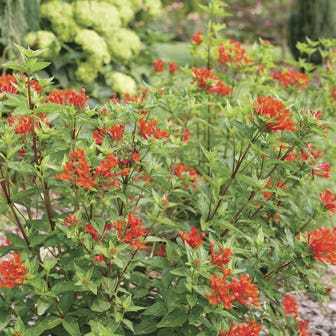My Cart
Checkout using your account
Checkout as a new customer
Creating an account has many benefits:
- See order and shipping status
- Track order history
- Check out faster
Perfect for pollinator, perennial, or cutting gardens
The Bouvardia genus contains flowering deciduous shrubs (evergreen in Zones 9b and higher), commonly called firecracker bushes. Long- and heavy-blooming, the prolific plants are in constant bloom from mid-spring to mid-fall, continuing all winter where temperatures stay above 60°F. These rare, exotic shrubs grow up to 4 feet tall, but are usually smaller, and set loose clusters of tubular, star- or trumpet-shaped flowers at the ends of branches. A favorite of hummingbirds, butterflies, and bees, the nectar-rich flowers are delicately scented and come in shades of red, reddish-orange, pink, yellow, or white—perfect for a pollinator, perennial, or cutting garden.
Bouvardia is a genus of about 30 species, which are native to Central America and Mexico, growing naturally among the boulders and rimrock of dry mountain sites in elevations of 3,000 to 6,500 feet. Two of the most popular and widely grown are B. longiflora (fragrant bouvardia), which is used in the floral industry and is often grown as houseplants; and B. ternifolia (firecracker bush, scarlet bouvardia, hummingbird flower [syn. B. glaberrima]), which extends its native range to regions in southwestern U.S., including to Arizona, New Mexico, and Texas and is most often used in home gardens and landscapes, along with B. hybrids.
Firecracker bushes grow and bloom best in sunny locations but tolerate dappled to part shade. They prefer nutrient-rich soils and benefit from monthly fertilization during the growing season, but they are adaptable to a wide range of soils, including clay and sandy loams, but the soil must be well-draining and have a neutral to slightly acidic pH. Firecracker bushes have a fair degree of drought tolerance and are suitable for xeriscapes as well as containers, indoors or out.



